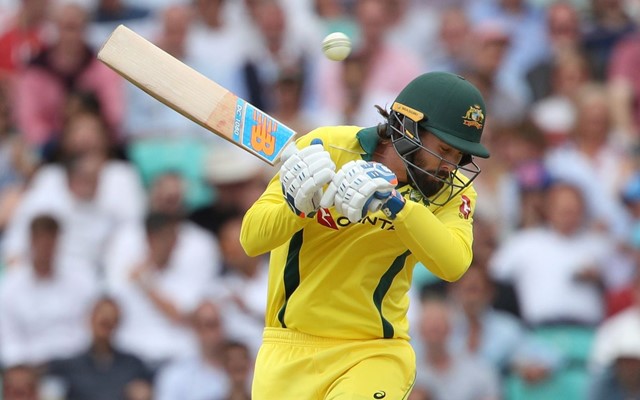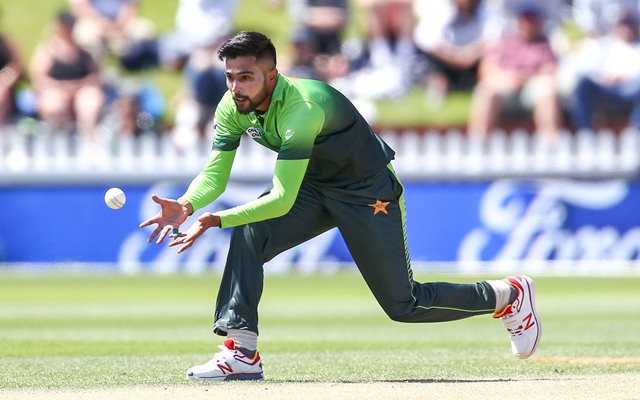Modern-day ODI rules that the previous generation might have found it tough
Here are a few new rules in ODI cricket which the previous generation might not have excelled.
5 Min Read


Kane Richardson. (Photo by Sarah Ansell/Getty Images).

Sachin Tendulkar, on Tuesday, responded to a tweet by ICC regarding the record for most partnership runs as a pair in ODIs which is held by himself and his partner Sourav Ganguly. Tendulkar took a cheeky dig at modern-day ODI cricket asking his former batting partner and the current BCCI chief, Ganguly about how many more runs they could have added in the current rules. He highlighted the usage of two new balls and only four fielders outside the circle during the middle overs starting from the early part of the 2010s.
This fueled up an already debate on how the ODI format is turning in batsmen’s favour and making things tough for the bowlers. Two new balls from two ends has ensured neither of the balls in usage lasts more than 25 overs. This doesn’t help the pacers to get reverse swing for a longer period.
The ever-evolving ODI format has seen various changes to the playing conditions. Every rule change has its own challenge which is not necessarily possible to be cracked by previous generation players as one expects.
Here are few new rules in ODI cricket which the previous generation might not have excelled:
3. Field restrictions and bye-runners:

Until 2005, the mandatory powerplay used to be for 15 overs where not more than two players were allowed outside the 30 yards circle. Two more players were needed to be in catching positions i.e. closer to the batsman in the inner circle around the pitch. This helps the batter to find the boundaries quite easily. With such a rule in existence, the present generation batsmen with an aggressive approach could score at an average of 8 runs an over in that period.
From 2005, the fielding restrictions were modified with 10 overs of mandatory powerplay followed by two blocks of 5-over powerplays where three fielders were allowed outside the circle. At present, four fielders are allowed to stay near the boundary once the mandatory powerplay of 10 overs concludes.
In fact, even the catching positions rule has been removed from 2012. Hence, the batsmen need to run a lot of singles and doubles during the middle overs giving a challenge to the fitness of the players.
Players around 1990s and 2000s were known to have misused the bye-runners rule which is one of the reasons why the runners have been barred from International Cricket since October 2011. Hence, in the current day of ODI cricket, the previous generation would have faced a challenge of being able to rotate strike for 40 overs. The requirement of finding boundaries was already there which could well drain out a player before they got a big score to their name.
2. Two new-balls:

The new balls from each end do not help reverse swing but it does help the new-ball exponent pacers get a swing for a slightly longer period. In special pitch conditions like moisture and grass cover, there is a greater possibility of a team’s top-order getting done inside an hour or even in ten overs. The stats do suggest the frequency of extreme top-order collapses against have increased in the recent decade.
A total of 16 instances of a team losing five wickets inside first 10 overs have been recorded across 1098 ODIs between top sides between January 1999 and September 2011. However, since October 2011, there have been 11 such instances across 604 ODI matches. As many as three times a team lost four wickets in the first five overs itself since the new ball rule which never happened between 1999 and 2011. (All numbers from the matches between top first 8 full-member nations)
On most occasions, the bowlers have complained about lack of swing despite the rule of two new balls. The reason for it has been a normal pitch used for an ODI match being helpful for high scores. But if the same rule existed on either side of 2000, the batsmen could have suffered even worse things. Who could imagine the Akram-Younis pair or a Pollock-Donald pair swinging a new ball each for five overs apiece?
1. Bouncers per over:

Not many of the present generation are aware that no legal bouncer were permitted in the ODI format through the 1990s. The ICC allowed one legal bouncer per over in ODI cricket from October 2001. The allowance increased to two legal bouncers from October 2012. During the 1990s, the fast bowlers were often penalized with no-balls and wides for bowling bouncers over shoulder height making them be extra careful that the short balls they bowled never crossed the limit.
Players who had their issues against short balls got away from facing those. In the current situation, such players would have found it tough to get away and score runs easily. The pacers are now allowed to bowl at least two bouncers above shoulder height but should not cross batsman’s head. The prime example for benefiting of not playing bouncers is Sourav Ganguly himself who expects to have added 4000 more partnership runs with Sachin Tendulkar.
The left-handed batsman often struggled against pacers especially in the second half of his career which coincided with the bowlers being allowed to bowl head height bouncers (in 2001). Until the bouncer rule, Ganguly averaged 43.81 with 16 centuries against top 10 teams and had an average of 45.19 as an opener alone. Against the same teams, Sourav averaged only 32.94 with just two tons in as many as 123 matches post the bouncer rule and 33.55 across 79 ODI innings as an opener.
Download Our App